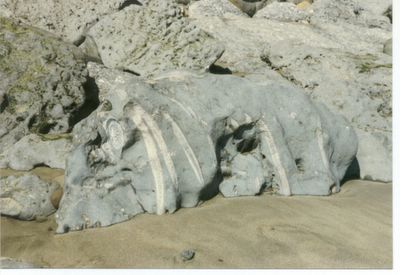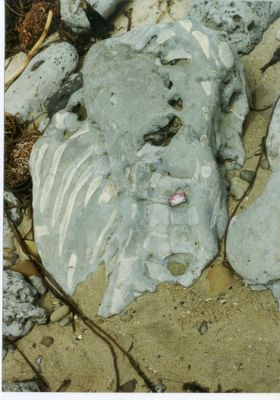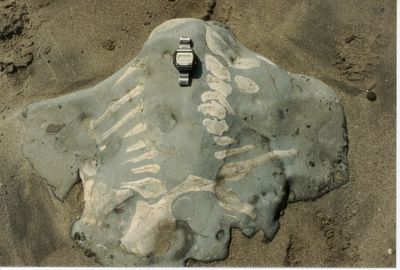





One day back in the winter of 1991, we went for a walk on the beach. We had walked this particular stretch of sand many times, but only at low tide, as it was inaccessible at high tide when the water lapped at the base of the cliffs. The walk between Capitola Beach and New Brighton runs along a cliff face that rises eighty feet above the beach and is striated with layers and layers of invertebrate fossils. In fact, it is so fossiliferous that it hardly drew our attention; it seemed so strangely commonplace. During minus tides we walked this beach for the tide pools -- always abundant with life-- crabs, anemones, starfish, octopus. On this particular day, after some powerful winter storms, the beach was entirely transformed. Much of the sand had been washed away, leaving large grey rocks exposed where the sandy beach had been. As we got closer to the rocks, we could see vertebrate fossils everywhere. We could hardly believe what had been under the sand all this time. Ribs and vertebrae as far as the eye could see. We knew the sand would eventually return and conceal these rocks again, so we returned the following day with a camera. These photos show some of what we saw. It was a couple of days or weeks later that most of the fossil bed was no longer visible. And all the years that we've gone back, we've never seen it like that again.
Current status:
In the mid- to late '90s, a group of property owners whose homes are on top of the cliff won approval from the City Council to form a Geological Hazard Abatement District to research and fund a seawall to protect their property from ongoing wave erosion. They were willing to bear the private cost of $2,000,000 to have a seawall constructed that would give their properties an estimated 75 to 100 additional years. The proposal called for a 1,257-foot seawall to be built along the base of the cliff. The structure, made of a material resembling a natural cliff face, would be 25 feet tall, with about 21 feet of it above ground against the 80-foot cliff. It would cover almost all of the paleontological record, in an effort to forestall the inevitable.
The seawall proposal sparked a lot of interest in the paleontological importance of this particular stretch of beach. An Environmental Impact Report (EIR) was generated that described the beach, "a strategically important section of the Purisima Formation, containing faunas spanning from the late Miocene through the Pliocene epoch and representing differing environments, and is visible and accessible..."
The beds are highly fossiliferous, yet no definitive work on the unit was conducted until the 1970s. According to Frank Perry, Paleontologist and Research Associate, Santa Cruz County Museum of Natural History and the Monterey Bay Paleontology Society, scientific research on the fossils within the area is ongoing. Research has revealed that marine terrestrial vertebrates and marine invertebrates are known be be abundant in the coastal Purisima Fourmation and the rock exposures to be excellent. The vertebrate fossils include: dolphins, whales, seals, sea lions, bony fish, sharks, rays, birds, horse and an amphibian. Some of the marine mammals taxa are new to science. The invertebrate list includes fossil bivalves, gastropods, scaphopods, bryozoans, crustaceans, brachiopods, sea stars, sponges, and echinoderms.
Part of the responsibility of the EIR was to determine the scientific significance of fossil resources:
"The Purisima strata within the project site contain scientifically significant fossils and are rated very high to paleontological sensitivity. The Purisima Formation is the most complete late Miocene to Pliocene stratigraphic section visible along the central California coast, based on the visibility, accessibility, completeness, and the abundant, diverse, and extremely well preserved paleontological resources. Vertebrate, invertebrate, and trace fossil materials are visible in outcrops and in deposits on the beach. Additional material may be visible periodically where tides are exceptionally low and/or sand/algae cover has been temporarily removed."
The homeowners' seawall proposal was voted down in November 2004. A great victory for some very old bones.
No comments:
Post a Comment